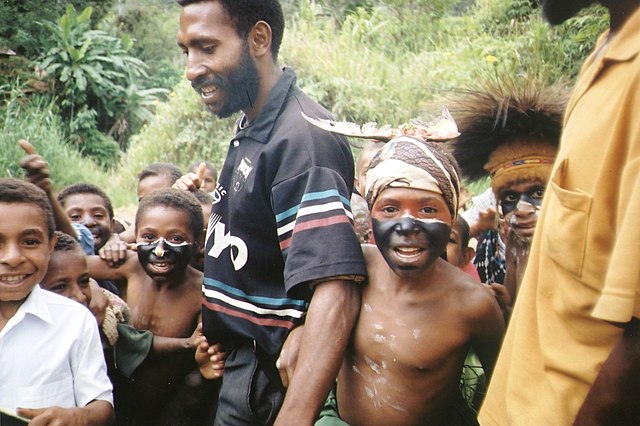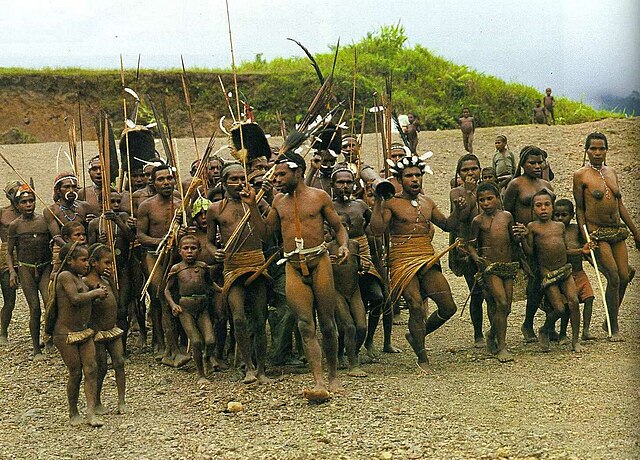Indigenous people of New Guinea
Melanesian inhabitants of New Guinea From Wikipedia, the free encyclopedia
The indigenous peoples of Western New Guinea in Indonesia and Papua New Guinea, commonly called Papuans,[2] are Melanesians. There is genetic evidence for two major historical lineages in New Guinea and neighboring islands: a first wave from the Malay Archipelago perhaps 50,000 years ago when New Guinea and Australia were a single landmass called Sahul and, much later, a wave of Austronesian people from the north who introduced Austronesian languages and pigs about 3,500 years ago. They also left a small but significant genetic trace in many coastal Papuan peoples.
 Dani people from the central highlands of Western New Guinea, Indonesia | |
| Total population | |
|---|---|
| 14,800,000 | |
| Regions with significant populations | |
| Papua New Guinea and Western New Guinea, Indonesia, Australia | |
| Languages | |
| Languages of Papua In Papuan New Guinea: Tok Pisin, Hiri Motu, Unserdeutsch and English In Indonesia: Papuan Malay and Indonesian | |
| Religion | |
| Christianity, Islam,[1] Traditional Faiths | |
| Related ethnic groups | |
| Other Melanesians, Ambonese, Moluccans, Aboriginal Australians, Malagasy people |
Linguistically, Papuans speak languages from the many families of non-Austronesian languages that are found only on New Guinea and neighboring islands, as well as Austronesian languages along parts of the coast, and recently developed creoles such as Tok Pisin, Hiri Motu, Unserdeutsch, and Papuan Malay.[3][4][5]
The term "Papuan" is used in a wider sense in linguistics and anthropology. In linguistics, "Papuan languages" is a cover term for the diverse, mutually unrelated, non-Austronesian language families spoken in Melanesia, the Torres Strait Islands, and parts of Wallacea. In anthropology, "Papuan" is often used to denote the highly diverse aboriginal populations of Melanesia and Wallacea prior to the arrival of Austronesian-speakers, and the dominant genetic traces of these populations in the current ethnic groups of these areas.[4]

Languages

Ethnologue's 14th edition lists 826 languages of Papua New Guinea and 257 languages of Western New Guinea, a total of 1083 languages, with 12 languages overlapping. If we adopt the figure proposed by Glottolog for Papua New Guinea, namely 928 languages,[6] the total is even higher. This corresponds to 15% of the world's 7700 languages.
In terms of linguistic families, the indigenous languages of New Guinea can be divided into two groups: 283 languages belong to the Austronesian family, and the other 858 are non-Austronesian[7]—a grouping commonly described as “Papuan languages” for convenience.
The term Papuan languages refers to an areal grouping, rather than a linguistic one. So-called “Papuan” languages are distributed into as many as eighty unrelated linguistic phyla, including 43 families and 37 isolates.[8]: 6
Papuan ethnic groups
Summarize
Perspective

The following indigenous peoples live within the modern borders of Indonesia and Papua New Guinea. Austronesian-speaking (AN) groups are given in italics.
Indonesia
West Papua
Papuan ethnic groups / tribes in the Indonesian province of West Papua include Arfak, Borai, Doreri, Hatam, Irarutu, Koiwai, Kuri, Madewana, Mairasi, Maniwak, Mbaham, Matta, Meiah, Miere, Meyah, Moire, Moru, Moskona, Napiti, Oburauw, Roon, Roswar, Sebyar, Sougb, Soviar, Sumuri, Wamesa, Warumba, Waruri, Wondama.[9]
Southwest Papua
Papuan ethnic groups / tribes in the Indonesian province of Southwest Papua include Abun, Ambel, Batanta, Biak (Betew, Kafdaron, Bikar, Usba, Wardo), Biga, Butlih, Domu, Fiawat, Imekko (Inanwatan-Bira, Matemani-Iwaro, Kais-Awe, Kokoda-Emeyode), Irires, Ma'ya (Kawe, Langanyan, Wawiyai), Matbat, Maybrat (Ayamaru, Mare, Karon Dori, Ayfat, Aytinyo), Meyah, Moi-Ma'ya, Moi, Mpur, Nerigo, Tehit, Tepin, Yahadian, Yaben-Konda.[9]
Papua
Papuan ethnic groups/tribes in the Indonesian province of Papua include:[10]
| Jayapura City |
|
|---|---|
| Jayapura Regency |
|
| Sarmi Regency |
|
| Keerom Regency |
|
| Biak Numfor Regency |
|
| Waropen Regency |
|
| Yapen Islands Regency |
|
| Mamberamo Regency |
Highland Papua
Papuan ethnic groups/tribes in the Indonesian province of Highland Papua include:[10]
| Jayawijaya Regency | |
|---|---|
| Pegunungan Bintang Regency | |
| Tolikara Regency |
|
| Yahukimo Regency |
|
Central Papua
Papuan ethnic groups/tribes in the Indonesian province of Central Papua include:[10]
South Papua
Papuan ethnic groups/tribes in the Indonesian province of South Papua include:[10]
| Merauke Regency |
|
|---|---|
| Asmat Regency | |
| Mappi Regency |
|
| Boven Digoel Regency |
Papua New Guinea
Bismarck Archipelago
- Girls from Papua New Guinea
- Papuan people in folk dress in Jakarta
- Newly married Kayu Batu couple in Jayapura, Indonesia
Origin and genetics
Summarize
Perspective
Phylogenetic position of the Papuan lineage among other East Eurasians.
Schematic summary of population settlement in Insular Southeast Asia, involving several East Eurasian lineages: (A) Initial occupation of Sunda and Sahul by ancestry related to modern New Guinean and Australian Aboriginal populations, followed by deep mainland Asian (Tianyuan- or Onge-related) ancestry. (B) Dispersals of ancestries associated with ancient Mainland Southeast Asian and ancestral Punan-related components predating the coastal South Chinese, and hence Austronesian-related, ancestries. (C) Austronesian expansion leading to Austronesian (Ami- and Kankanaey-related) ancestry observed in NE and SE Borneans and subsequent specific Papuan ancestry admixture observed in the Lebbo population in East Borneo.
The origin of Papuans is generally associated with the first settlement of Australasia by a lineage dubbed 'Australasians' or 'Australo-Papuans' during the Initial Upper Paleolithic, which is "ascribed to a population movement with uniform genetic features and material culture" (Ancient East Eurasians), and sharing deep ancestry with modern East Asian peoples and other Asia-Pacific groups.[12][13][14] It is estimated that people reached Sahul (the geological continent consisting of Australia and New Guinea) between 50,000 and 37,000 years ago. Rising sea levels separated New Guinea from Australia about 10,000 years ago. However, Aboriginal Australians and Papuans had diverged genetically much earlier, around 40,000 years BP. Papuans are more closely related to Melanesians than to Aboriginal Australians.[15][14]
Haplogroups
The majority of Papuan Y-DNA Haplogroups belong to subclades of Haplogroup MS, and Haplogroup C1b2a. The frequency of each haplogroup varies along geographic clines.[16][17]
Autosomal DNA
The genetic makeup of Papuans is primarily derived from Ancient East Eurasians, which relates them to other mainland Asian groups such as the "AASI", Andamanese, as well as East/Southeast Asians, although Papuans may have also received some gene flow from an earlier group (xOoA), around 2%,[18] next to additional archaic Denisovan admixture in the Sahul region. Papuans may harbor varying degrees of deep admixture from "a lineage basal to West and East-Eurasians which occurred sometimes between 45 and 38kya", although they are generally regarded "as a simple sister group of Tianyuan" ("Basal East Asians").[13][14][12]

There is evidence that the ancestors of Papuans and related groups "underwent a strong bottleneck before the settlement of the region, and separated around 20,000–40,000 years ago".[19]
Papuans display pronounced genetic diversity, explained through isolation and drift between different subgroups after the settlement of New Guinea. The most notable differentiation was found to be between Highlanders and Lowlanders. Papuan Highlanders fall into three clusters, but form a single clade compared against Lowlanders. The Highlanders underwent a population bottleneck around 10,000 years ago, associated with the adoption of Neolithic lifestyles. Papuan Lowlanders display increased diversity and can be broadly differentiated into a Southern Lowlander cluster and a Northern Lowlander cluster. The genetic differentiation among Papuans is suggested to date back at least 20kya, while the sub-structure among Highlanders dates back around 10kya, with higher diversity among western Highlanders than Eastern ones. The genetic diversity is paralleled by linguistic and cultural diversity.[20]
Archaic introgression
Based on his genetic studies of the Denisova hominin, an ancient human species discovered in 2010, Svante Pääbo claims that ancient human ancestors of the Papuans interbred in Asia with these humans. He has found that people of New Guinea share 4%–7% of their genome with the Denisovans, indicating this exchange.[21] Denisovan introgressions may have influenced the immune system of present-day Papuans and potentially favoured "variants to immune-related phenotypes" and "adaptation to the local environment".[22]
ASPM gene
In a 2005 study of ASPM gene variants, Mekel-Bobrov et al. found that the Papuan people have among the highest rate of the newly evolved ASPM Haplogroup D, at 59.4% occurrence of the approximately 6,000-year-old allele.[23] While it is not yet known exactly what selective advantage is provided by this gene variant, the haplogroup D allele is thought to be positively selected in populations and to confer some substantial advantage that has caused its frequency to rapidly increase.
Notable people
- Abba Bina, Papua New Guinean businessman and politician
- Archie Thompson, former Australian soccer player
- Elie Aiboy, former Indonesian footballer
- Marlina Flassy, Indonesian anthropologist and the first woman to be appointed Dean of Cenderawasih University
- Frans Kaisiepo, 4th Governor of Papua and National Hero of Indonesia
- Nitya Krishinda Maheswari, Indonesian badminton player and 2014 Asian Games women's doubles gold medalist
- Nowela Auparay, professional singer and Indonesian Idol winner
- Peter O'Neill, 7th Prime Minister of Papua New Guinea
- Freddy Numberi, Indonesian politician and former Minister of Transportation
- Raema Lisa Rumbewas, Indonesian weightlifter and silver medallist at the 2000 and 2004 Summer Olympics
- Boaz Solossa, Indonesian footballer
- Titus Bonai, Indonesian footballer
- Ricky Kambuaya, Indonesian footballer
- Michael Somare, former Prime Minister of Papua New Guinea
- Heather Watson, English female tennis player
- Benny Wenda, West Papuan independence leader.
- Machmud Singgirei Rumagesan, King of Sekar and National Hero of Indonesia
- Abdul Hakim Achmad Aituarauw, Member of People's Representative Council
- Alwin Komolong
- Kusuga Komolong
- Saiful Islam Al-Payage, Indonesian Islamic preacher
See also
- Aboriginal Australians
- Indigenous Australians
- Koteka Tribal Assembly
- List of ethnic groups of West Papua
- Malagasy people (Africa)
- Moluccans (to the west of New Guinea)
- Negrito (Southeast Asia)
- Papua conflict
- Proto-Australoid
- Stéphane Breton (filmmaker)
- Torres Strait Islanders between New Guinea and mainland Australia (including the Meriam people, whose language family is otherwise found in New Guinea)
References
Further reading
External links
Wikiwand - on
Seamless Wikipedia browsing. On steroids.




